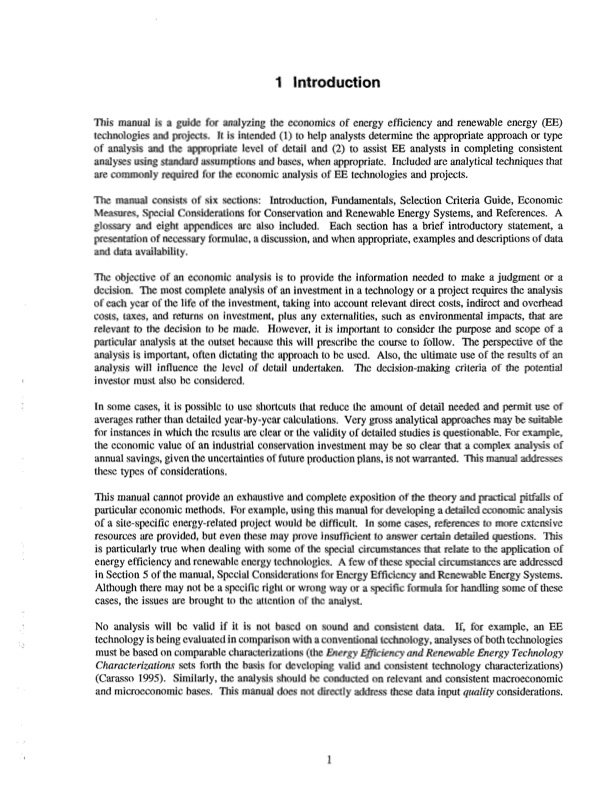
PDF Publication Title:
Text from PDF Page: 009
1 Introduction This manual is a guide for analyzing the economics of energy efficiency and renewable energy (EE) technologies and projects. It is intended (1) to help analysts determine the appropriate approach or type of analysis and the appropriate level of detail and (2) to assist EE analysts in completing consistent analysesusingstandardassumptionsandbases,whenappropriate. Includedareanalyticaltechniquesthat are commonly required for the economic analysis of EE technologies and projects. The manual consists of six sections: Introduction, Fundamentals, Selection Criteria Guide, Economic Measures,SpecialConsiderationsforConservationandRenewableEnergySystems,andReferences. A glossary and eight appendices are also included, Each section has a brief introductory statement, a presentation of necessary formulae, a discussion, and when appropriate, examples and descriptions of data and data availability. The objective of an economic analysis is to provide the information needed to make a judgment or a decision. Themostcompleteanalysisofaninvestmentinatechnologyoraprojectrequirestheanalysis of each year of the life of the investment, taking into account relevant direct costs, indirect and overhead costs, taxes, and returns on investment, plus m y externalities, such as environmental impacts, that are relevant to the decision to be made. However, it is important to consider the purpose and scope of a particularanalysisattheoutsetbecausethiswillprescribethecoursetofollow. Theperspectiveofthe analysisisimportant,oftendictatingtheapproachtobeused. Also,theultimateuseoftheresultsofan analysis will influence the level of detail undertaken. The decision-making criteria of the potential investor must also be considered. In some cases, it is possible to use shortcuts that reduce the amount of detail needed and permit use of averages rather than detailed year-by-year calculations. Very gross analpcal approaches may be suitable for instances in which the results are clear or the validity of detailed studies is questionable. For example, the economic value of an industrial conservation investment may be so clear that a complex analysis of annualsavings,giventheuncertaintiesoffukreproductionplans,isnotwarranted. Thismanualaddresses these types of considerations. This manual cannot provide an exhaustive and complete exposition of the theory and practical pitfalls of particulareconomicmethods. Forexample,usingthismanualfordevelopingadetailedeconomicanalysis of a site-specific energy-related project would be difficult. In some cases, references to more extensive resourcesareprovided,buteventhesemayproveinsufficienttoanswercertaindetailedquestions. This is particularly true when dealing with some of the special circumstances that relate to the application of energy efficiency and renewable energy technologies. A few of these special circumstances are addressed in Section 5 of the manual, Special Considerationsfor Energy Efficiency and Renewable Energy Systems. Although there may not be a specific right or wrong way or a specific formula for handling some of these cases, the issues are brought to the attention of the analyst. No analysis will be valid if it is not based on sound and consistent data. If, for example, an EE technologyisbeingevaluatedincomparisonwithaconventionaltechnology,analysesofbothtechnologies must be based on comparable characterizations (the Energy EfSiciency and Renewable Energy Technology Characterizations sets forth the basis for developing valid and consistent technology characterizations) (Carasso 1995). Similarly, the analysis should be conducted on relevant and consistent macroeconomic andmicroeconomicbases. Thismanualdoesnotdirectlyaddressthesedatainputquulityconsiderations. 1PDF Image | A Manual for the Economic Evaluation of Energy Efficiency and Renewable Energy Technologies

PDF Search Title:
A Manual for the Economic Evaluation of Energy Efficiency and Renewable Energy TechnologiesOriginal File Name Searched:
5173.pdfDIY PDF Search: Google It | Yahoo | Bing
NFT (Non Fungible Token): Buy our tech, design, development or system NFT and become part of our tech NFT network... More Info
IT XR Project Redstone NFT Available for Sale: NFT for high tech turbine design with one part 3D printed counter-rotating energy turbine. Be part of the future with this NFT. Can be bought and sold but only one design NFT exists. Royalties go to the developer (Infinity) to keep enhancing design and applications... More Info
Infinity Turbine IT XR Project Redstone Design: NFT for sale... NFT for high tech turbine design with one part 3D printed counter-rotating energy turbine. Includes all rights to this turbine design, including license for Fluid Handling Block I and II for the turbine assembly and housing. The NFT includes the blueprints (cad/cam), revenue streams, and all future development of the IT XR Project Redstone... More Info
Infinity Turbine ROT Radial Outflow Turbine 24 Design and Worldwide Rights: NFT for sale... NFT for the ROT 24 energy turbine. Be part of the future with this NFT. This design can be bought and sold but only one design NFT exists. You may manufacture the unit, or get the revenues from its sale from Infinity Turbine. Royalties go to the developer (Infinity) to keep enhancing design and applications... More Info
Infinity Supercritical CO2 10 Liter Extractor Design and Worldwide Rights: The Infinity Supercritical 10L CO2 extractor is for botanical oil extraction, which is rich in terpenes and can produce shelf ready full spectrum oil. With over 5 years of development, this industry leader mature extractor machine has been sold since 2015 and is part of many profitable businesses. The process can also be used for electrowinning, e-waste recycling, and lithium battery recycling, gold mining electronic wastes, precious metals. CO2 can also be used in a reverse fuel cell with nafion to make a gas-to-liquids fuel, such as methanol, ethanol and butanol or ethylene. Supercritical CO2 has also been used for treating nafion to make it more effective catalyst. This NFT is for the purchase of worldwide rights which includes the design. More Info
NFT (Non Fungible Token): Buy our tech, design, development or system NFT and become part of our tech NFT network... More Info
Infinity Turbine Products: Special for this month, any plans are $10,000 for complete Cad/Cam blueprints. License is for one build. Try before you buy a production license. May pay by Bitcoin or other Crypto. Products Page... More Info
| CONTACT TEL: 608-238-6001 Email: greg@infinityturbine.com | RSS | AMP |